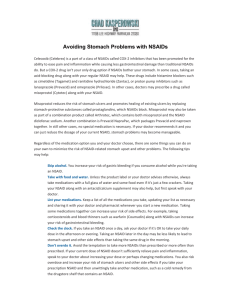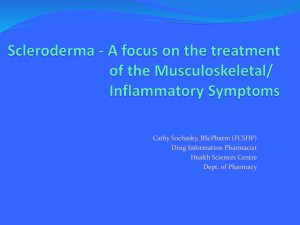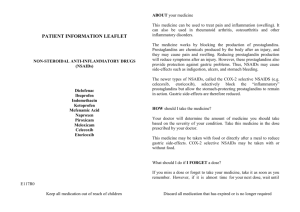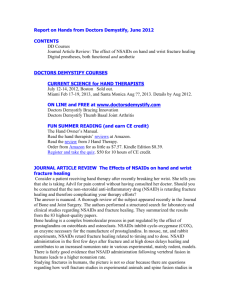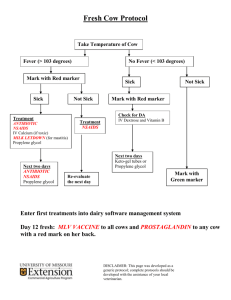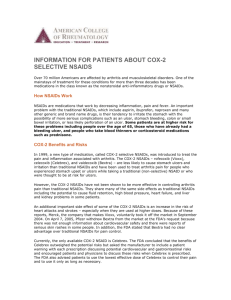What are NSAIDs? - Australian Rheumatology Association
advertisement
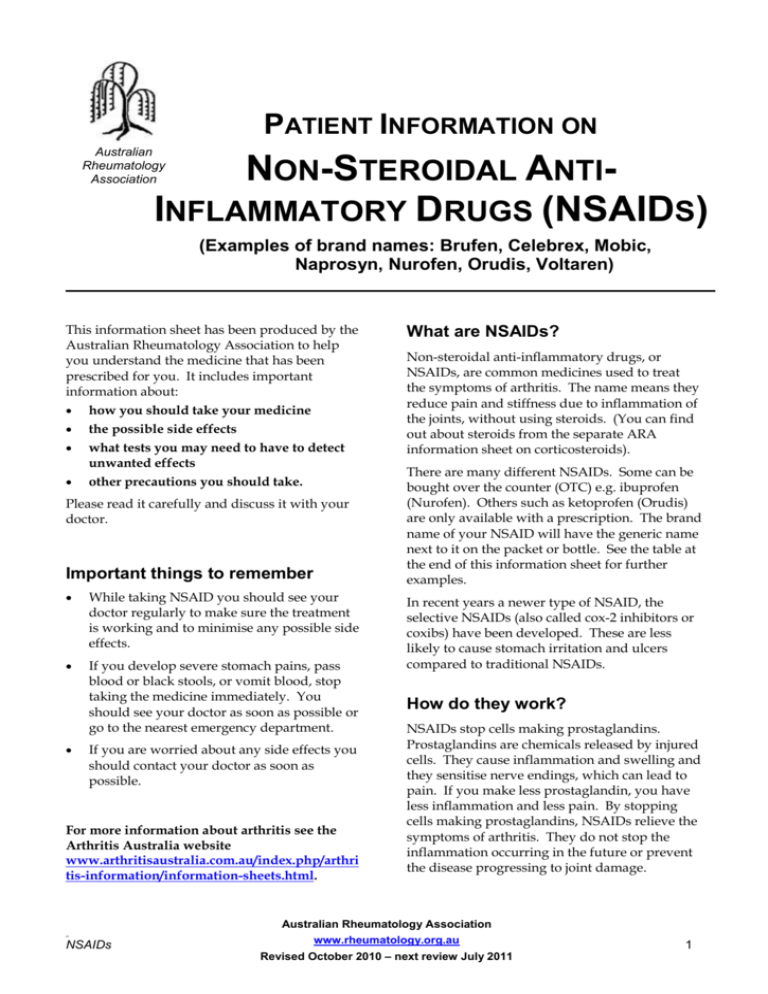
PATIENT INFORMATION ON Australian Rheumatology Association NON-STEROIDAL ANTIINFLAMMATORY DRUGS (NSAIDS) (Examples of brand names: Brufen, Celebrex, Mobic, Naprosyn, Nurofen, Orudis, Voltaren) This information sheet has been produced by the Australian Rheumatology Association to help you understand the medicine that has been prescribed for you. It includes important information about: how you should take your medicine the possible side effects what tests you may need to have to detect unwanted effects other precautions you should take. Please read it carefully and discuss it with your doctor. Important things to remember While taking NSAID you should see your doctor regularly to make sure the treatment is working and to minimise any possible side effects. If you develop severe stomach pains, pass blood or black stools, or vomit blood, stop taking the medicine immediately. You should see your doctor as soon as possible or go to the nearest emergency department. If you are worried about any side effects you should contact your doctor as soon as possible. For more information about arthritis see the Arthritis Australia website www.arthritisaustralia.com.au/index.php/arthri tis-information/information-sheets.html. 27 NSAIDs What are NSAIDs? Non-steroidal anti-inflammatory drugs, or NSAIDs, are common medicines used to treat the symptoms of arthritis. The name means they reduce pain and stiffness due to inflammation of the joints, without using steroids. (You can find out about steroids from the separate ARA information sheet on corticosteroids). There are many different NSAIDs. Some can be bought over the counter (OTC) e.g. ibuprofen (Nurofen). Others such as ketoprofen (Orudis) are only available with a prescription. The brand name of your NSAID will have the generic name next to it on the packet or bottle. See the table at the end of this information sheet for further examples. In recent years a newer type of NSAID, the selective NSAIDs (also called cox-2 inhibitors or coxibs) have been developed. These are less likely to cause stomach irritation and ulcers compared to traditional NSAIDs. How do they work? NSAIDs stop cells making prostaglandins. Prostaglandins are chemicals released by injured cells. They cause inflammation and swelling and they sensitise nerve endings, which can lead to pain. If you make less prostaglandin, you have less inflammation and less pain. By stopping cells making prostaglandins, NSAIDs relieve the symptoms of arthritis. They do not stop the inflammation occurring in the future or prevent the disease progressing to joint damage. Australian Rheumatology Association www.rheumatology.org.au Revised October 2010 – next review July 2011 1 What benefit can you expect from your treatment? NSAIDs provide relief from pain and stiffness. They work quickly, usually within a few hours. The maximum benefit can take 2-4 weeks or sometimes longer. You may need to try two or three different NSAIDs to find one that suits you best. You must only take one type of NSAID at a time. How are NSAIDs taken? NSAIDs are usually taken by mouth in tablet or capsule form. They are also available as liquids, injections, creams, sprays and suppositories. Side effects may still occur with any method of administration, even when NSAIDs are applied to the skin (see Side effects). When should they be taken? NSAIDS can be taken when needed to treat short term symptoms. They can also be taken regularly to manage persistent pain and stiffness. While NSAIDs may be more effective if taken regularly, the possible side effects are less if they are only taken when needed, for example before exercise. How often you take NSAIDs also depends on which one you are prescribed. Ask your doctor or pharmacist if you are uncertain about how often to take your medicine. NSAIDs may be used with other arthritis medicines including: DMARDs (anti rheumatoid arthritis drugs) such as methotrexate simple pain medicines such as paracetamol. Corticosteroids are not generally used with NSAIDs as the risk of side effects such as ulcer is increased. How long is the treatment continued? Treatment with NSAIDs can be for a short period or long term. A NSAID should not be continued indefinitely without regular review by your doctor to confirm the NSAID still works and no serious side effects are occurring. Are there any side effects? Below are some of the possible side effects that you might experience with your treatment. Tell your doctor if you experience any problems. A reduction in dose or change to another NSAID may decrease the side effects so that you can continue to take the medicine. Alternatively, your doctor may recommend a different pain relieving medicine with fewer potential side effects, such as paracetamol. This may allow you take the NSAID less often or stop it altogether. Most common possible side effects: The most common side effects are gastrointestinal and may include decreased appetite, nausea (feeling sick), vomiting, diarrhoea, constipation, heart burn and stomach pain or cramps. Heart disease and stroke: All NSAIDs, including the newer selective types (cox-2 inhibitors/coxibs), may slightly increase the risk of heart attacks and strokes. This risk seems higher in those already at high risk of heart attack or stroke. To minimise side effects, the lowest dose which controls symptoms is usually recommended. NSAIDs can increase blood pressure (see Precautions, page 3). Always follow the instructions provided in the packaging unless otherwise directed by your doctor. NSAIDs can make heart failure or kidney failure worse. Fluid retention can lead to weight gain or swelling of ankles or legs. Kidney failure is more likely if you are also taking fluid tablets and certain blood pressure tablets (see Precautions, page 3). Dizziness, lightheadedness, tiredness, ringing in the ears (tinnitus) and headache can occur. Tablets and capsules should be taken with food to reduce possible side effects. What is the dosage? NSAIDs usually come in different strengths. Treatment usually starts with a low dose. This can be adjusted depending on your response. The dose will depend on the type of NSAID and the condition for which it is being used. Are other medicines taken with NSAIDs? To minimise side effects, sometimes a medicine to protect the stomach may be given (see page 3). 27 NSAIDs Australian Rheumatology Association www.rheumatology.org.au Revised October 2010 – next review July 2011 2 Bleeding more easily than usual is often noticed. Less common or rare possible side effect: What precautions are necessary? Blood pressure There are some rare but potentially serious side effects with NSAIDs. Stomach or duodenal ulcers: NSAIDs can cause ulcers in the stomach or duodenum (upper bowel). If you develop severe stomach pains, pass blood or black stools, or vomit blood, stop taking the medicine immediately. You should see your doctor as soon as possible or go to the nearest emergency department. The risk of ulcers is higher if: - you are older than 65 years - you have had a previous stomach or duodenal ulcer - you are also taking warfarin, corticosteroid tablets or low-dose aspirin (used by many people to help prevent a heart attack or stroke). If you have an infection (helicobacter bacteria) in your stomach this should be treated before you start NSAIDs. Your doctor may advise that you take an anti-ulcer medicine to help reduce the risk of getting a stomach or duodenal ulcer. The selective NSAIDs e.g. celecoxib ( brand name Celebrex), may be less likely to cause stomach ulcers and irritation than traditional NSAIDs. They have been used to treat arthritis in people who have suffered stomach upset or ulcers while taking a traditional NSAID or who were thought to be at risk for ulcers. Allergy to NSAIDs can occur resulting in skin rashes. Shortness of breath may occur in some people with asthma. Seek medical help if your asthma suddenly becomes worse after taking NSAIDs. Blood tests Usually blood tests are not required for people taking NSAIDs. They may be needed in certain situations. For example, your kidney function may need to be monitored if you have other risk factors for reduced kidney function, such as being over 65 years old and taking blood pressure medicines or fluid tablets. In this case your doctor may recommend you have a blood test in the first few weeks after starting a NSAID. Other medicines NSAIDs can interact with other medicines. You should tell your doctor (including your general practitioner, rheumatologist and others) about all medicines you are taking, including herbal and naturopathic medicines. This includes OTC medicines as some contain NSAIDs. You should also mention your treatment when you see other health professionals. NSAIDs are generally used for joint and muscle pain. However sometimes they can be used for other reasons, for example mefanamic acid (Ponstan) may be used for period pain. Despite the possible increased risk of ulcer, low doses of aspirin used to prevent heart attack and stroke can probably be used safely with NSAIDs if the risk for ulcer is low in the first place. Methotrexate for rheumatoid arthritis or other arthritis treatment can be taken safely with NSAIDs, as long as your kidney function is normal. The simple pain reliever paracetamol, and combined medicines such as Panadeine and Liver inflammation (hepatitis) is another uncommon side effect. There are also a number of other uncommon side effects. Read the leaflet that comes with the medicine, which lists all the precautions and possible side effects. 27 NSAIDs Because NSAIDs can affect your blood pressure, it is a good idea to have your blood pressure monitored monthly for the first two months. This is more important if you already have high blood pressure or you are on treatment for high blood pressure. If your blood pressure is stable, it should be checked every 3 to 6 months while you continue to take the NSAIDs. Australian Rheumatology Association www.rheumatology.org.au Revised October 2010 – next review July 2011 3 Panadeine Forte can be used while taking NSAIDs provided you take them as directed. NSAIDs are not recommended during pregnancy or during breastfeeding, unless specifically advised by your doctor. If you are planning a family or you become pregnant you should discuss this with your doctor as soon as possible. Some studies suggest that if NSAIDs are taken around the time of conception, there may be an increased risk of miscarriage. If NSAIDs are taken in later stages of pregnancy they may have an effect on the blood vessels near the baby’s heart. Paracetamol does not have these effects. If you are taking anticoagulants such as warfarin you should tell your doctor as combination with NSAIDs can increase the risk of bleeding. Alcohol Pregnancy and breastfeeding NSAIDs can increase the risk of an ulcer. Heavy alcohol use (more than 4 standard drinks in one session) should be avoided while taking these medicines. Non-selective NSAIDS (cox-1 and cox-2 inhibitors) Generic/chemical name Brand names Diclofenac Chemists’ Own, Clonac, Diclohexal, Fenac, Imflac, Voltaren, Voltaren Rapid, Volfast Ibuprofen Advil, Brufen, Bugesic, Chemists’ Own, Gold Cross, Herron Blue, iProfen, Nurofen, Panafen, ProVen, Rafen, Tri-Profen Indomethacin Arthrexin, Indocid Ketoprofen Orudis, Oruvail Ketorolac Ketoral, Toradol Naproxen Aleve, Anaprox, Chemists’ Own, Crysanal, Eazydayz, Inza, Naprosyn, Naprogesic, Naproleve, Nurolasts, Proxen Piroxicam Feldene, Feldene-D, Mobilis, Mobilis D, Piroxicam Sulindac Aclin Tiaprofenic acid Surgam Selective NSAIDS (cox-2 inhibitors) Celecoxib Celebrex Etoricoxib Arcoxia Meloxicam Meloxibell, Mobic, Movalis, Moxicam Source: Australian Medicines Handbook, 2010. Note: This may not be a comprehensive list – ask your pharmacist or doctor for more information. Questions? Your doctor’s contact details: If you have any questions or concerns write them down and discuss them with your doctor. When taking NSAIDs should see your doctor regularly to make sure the treatment is working and to minimise any potential side effects. The information in this sheet has been obtained from various sources and has been reviewed by the Australian Rheumatology Association. It is intended as an educational aid and does not cover all possible uses, actions, precautions, side effects, or interactions of the medicines mentioned. This information is not intended as medical advice for individual problems nor for making an individual assessment of the risks and benefits of taking a particular medicine. It can be reproduced in its entirety but cannot be altered without permission from the ARA. The NHMRC publication: How to present the evidence for consumers: preparation of consumer publications (2000) was used as a guide in developing this publication. 27 NSAIDs Australian Rheumatology Association www.rheumatology.org.au Revised October 2010 – next review July 2011 4
